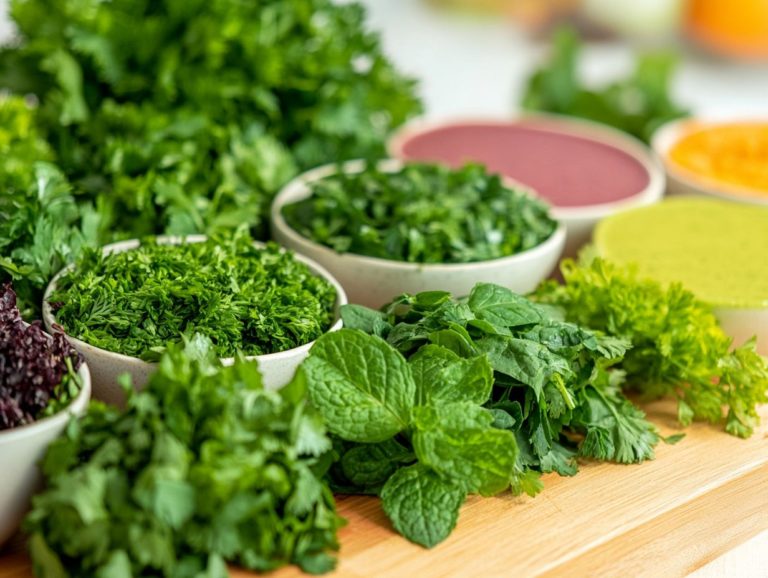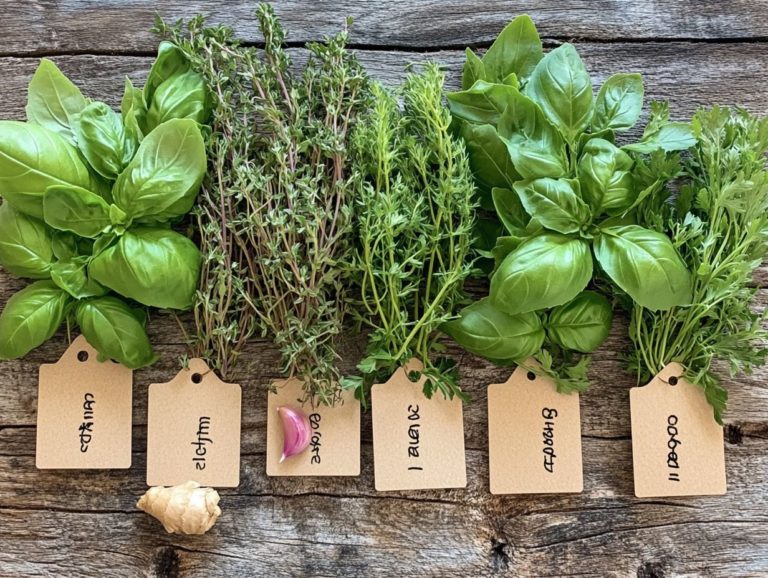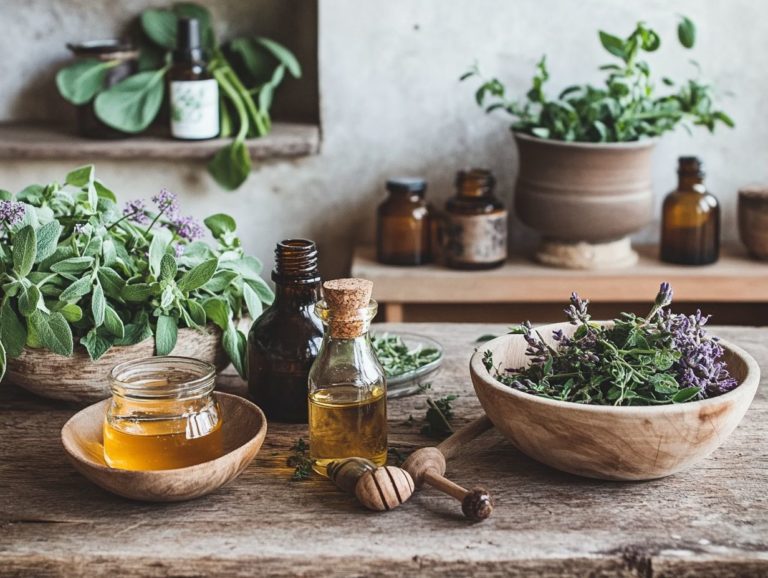The Best Practices for Harvesting Herbs
Harvesting herbs is more than just a task; it s a vital ritual that enriches both the flavor and nutrition of your culinary creations.
Understanding when and how to harvest can greatly influence the quality of your herbs. This article explores the ideal timing for peak flavor, various harvesting techniques, and preservation methods to keep your herbs fresh and ready for use.
You ll discover common pitfalls to avoid, helping your plants flourish while maximizing their culinary and medicinal benefits. Get ready to take your herb game to the next level!
Contents
Key Takeaways:

- Harvest herbs at the right time to ensure optimal flavor and nutrient content.
- Choose the appropriate method for harvesting, whether hand-picking or using tools, to avoid damage to plants and loss of quality.
- Properly preserve your harvested herbs through drying, freezing, or other techniques to prolong their shelf life and retain their potency.
Why Harvesting Herbs is Important
Harvesting herbs is essential for cultivating a sustainable lifestyle. It allows you to connect with nature while growing fresh ingredients bursting with flavor and medicinal properties.
This practice supports your health by providing a rich source of vitamins and antioxidants, often more beneficial than what you ll find on store shelves. As a culinary enthusiast, you can elevate your dishes with vibrant herbs like basil, known for its anti-inflammatory properties, or chives, which add a subtle onion flavor while promoting heart health. Lavender, with its delightful aroma, enhances your meals and teas and offers calming effects for the mind.
By embracing sustainable gardening practices, you can significantly reduce your carbon footprint, contribute positively to the environment, and support biodiversity. These choices lead to meaningful changes in your lifestyle, proving that every little effort counts.
When to Harvest Herbs
Knowing when to harvest herbs is crucial for maximizing both flavor and nutrient content. This ensures your culinary creations shine with richness and satisfaction.
The timing varies by herb type; for instance, annual herbs like cilantro are best harvested just before flowering, while perennial herbs like thyme can be clipped throughout their growing season.
By understanding the specific needs of each herb, from basil to chives, you enhance the flavor intensity of your dishes and adopt a sustainable approach to herb harvesting.
Timing for Optimal Flavor and Nutrient Content
The timing of your herb harvesting is essential for maximizing both flavor and nutrient content. For herbs like basil and chives, aim for an early morning harvest when essential oils are at their peak concentration. Other herbs have their own optimal harvesting times that preserve their medicinal properties.
Keep in mind factors such as growth stages and weather conditions; these nuances significantly impact the quality of your harvested herbs. It s crucial for any serious herb gardener to understand them.
Harvesting in the late afternoon, after the dew has evaporated, can also benefit certain herbs. The sun promotes more robust flavor profiles by reducing moisture levels. For instance, rosemary and thyme flourish when picked just before flowering, enhancing their oils and nutrients, enriching your dishes with aromatic depth.
Similarly, herbs like peppermint and sage respond remarkably well to harvesting right before rainfall, leveraging natural hydration to boost their flavor.
By attuning yourself to these environmental cues, you can safeguard your harvest and maximize the benefits each plant has to offer.
Methods for Harvesting Herbs
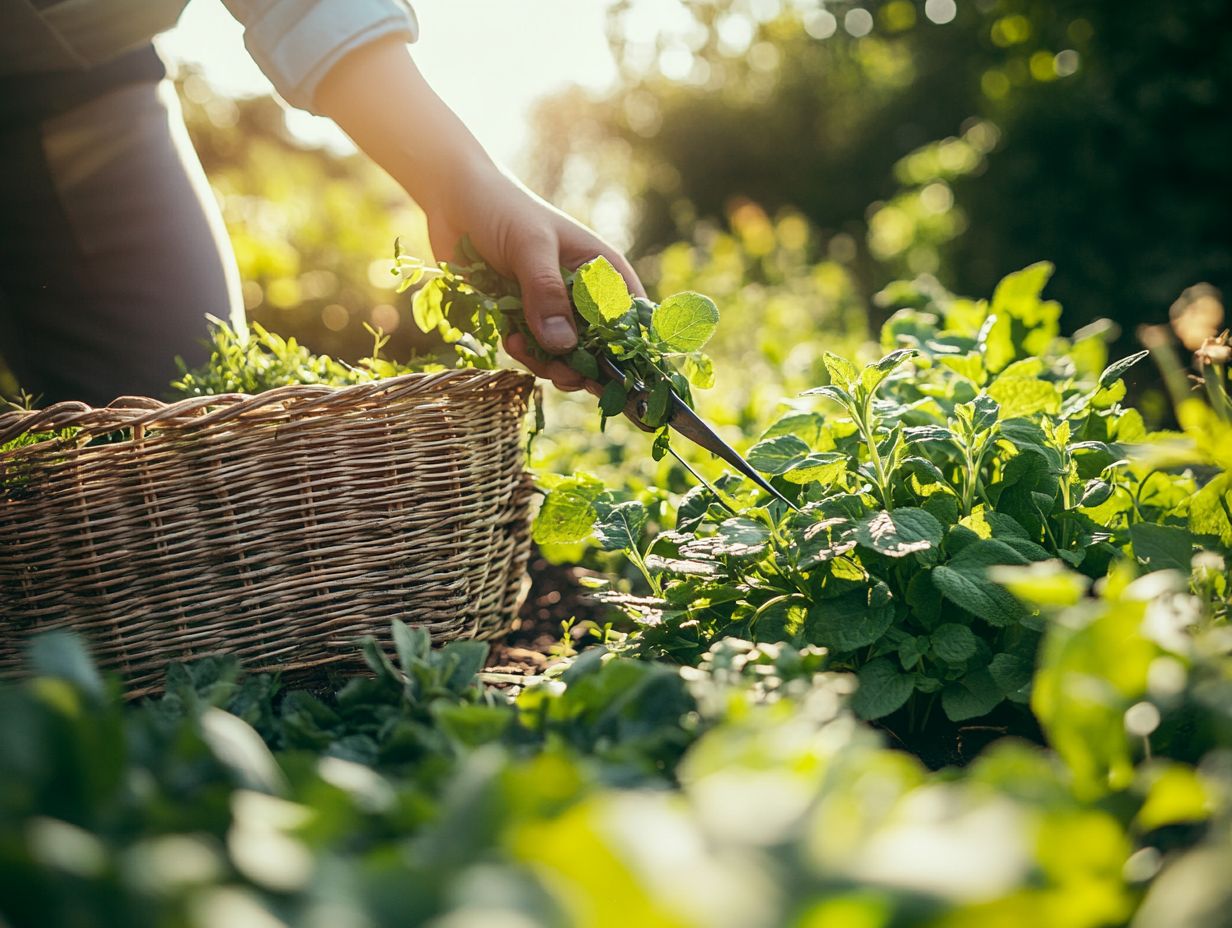
Selecting the right methods for harvesting herbs is crucial for maintaining their quality and potency. Whether you opt for hand-picking or specialized tools, each approach has its own benefits.
Hand-picking is gentler on delicate herbs like basil and cilantro. This method allows you to select the freshest portions while minimizing harm to the plant.
On the other hand, using tools can greatly improve efficiency, especially for larger quantities of perennial herbs such as rosemary or thyme.
Understanding the pros and cons of each technique empowers you to make informed choices that lead to a successful and rewarding harvest.
Hand-Picking vs. Using Tools
When deciding between hand-picking or using tools, remember that each method impacts the quality and longevity of your herbs.
Hand-picking allows for meticulous selection, which is especially beneficial for delicate herbs like basil or chives. This ensures that you re gathering the freshest leaves.
Using tools like garden shears makes harvesting quicker for robust herbs such as rosemary. This method allows you to harvest efficiently without causing excessive wear on the plant.
Finding the right balance between efficiency and care is essential for a successful herb harvest.
The method you choose often depends on the specific context and type of herb you re working with. For instance, mint and cilantro have tender leaves that benefit from gentle hand-picking to avoid bruising, which could affect their flavor and overall quality.
For sturdier herbs like sage or thyme, using shears can help you maintain the plant’s growth while efficiently gathering larger quantities.
Learn the ins and outs of each harvesting method to boost your herbs’ health and your harvesting speed!
Preserving Harvested Herbs
Effectively preserving your harvested herbs is essential for maintaining their rich flavor, medicinal properties, and culinary potential. This lets you savor them long after the growing season has ended.
Techniques such as drying, freezing, and creating herb-infused oils can significantly extend their shelf life while preserving their vital essence. Each preservation method has its advantages. For example, air-drying is great for robust herbs like oregano. Freezing works wonders for delicate herbs such as basil, helping to retain their essential oils and flavor intensity.
Drying, Freezing, and Other Preservation Techniques
Preservation techniques are essential for extending the shelf life of your harvested herbs while maintaining their cooking quality.
As an herb enthusiast, consider the unique characteristics of your plants. Some preservation methods work better than others depending on the herb’s structure and flavor profile.
For example, while air-drying allows moisture to evaporate, it can dull the vibrant colors and essential oils of delicate herbs. Freezing captures that fresh taste and keeps the original flavor intact, making it particularly effective for soft herbs like parsley and dill.
Infusing oils opens up a world of culinary possibilities, letting you enhance dishes with rich flavors. By understanding these preservation methods, you can ensure that the essence of your herbs is preserved, enabling you to enjoy their bounty throughout the year. Don t miss out on enjoying your herbs all year long!
Common Mistakes to Avoid
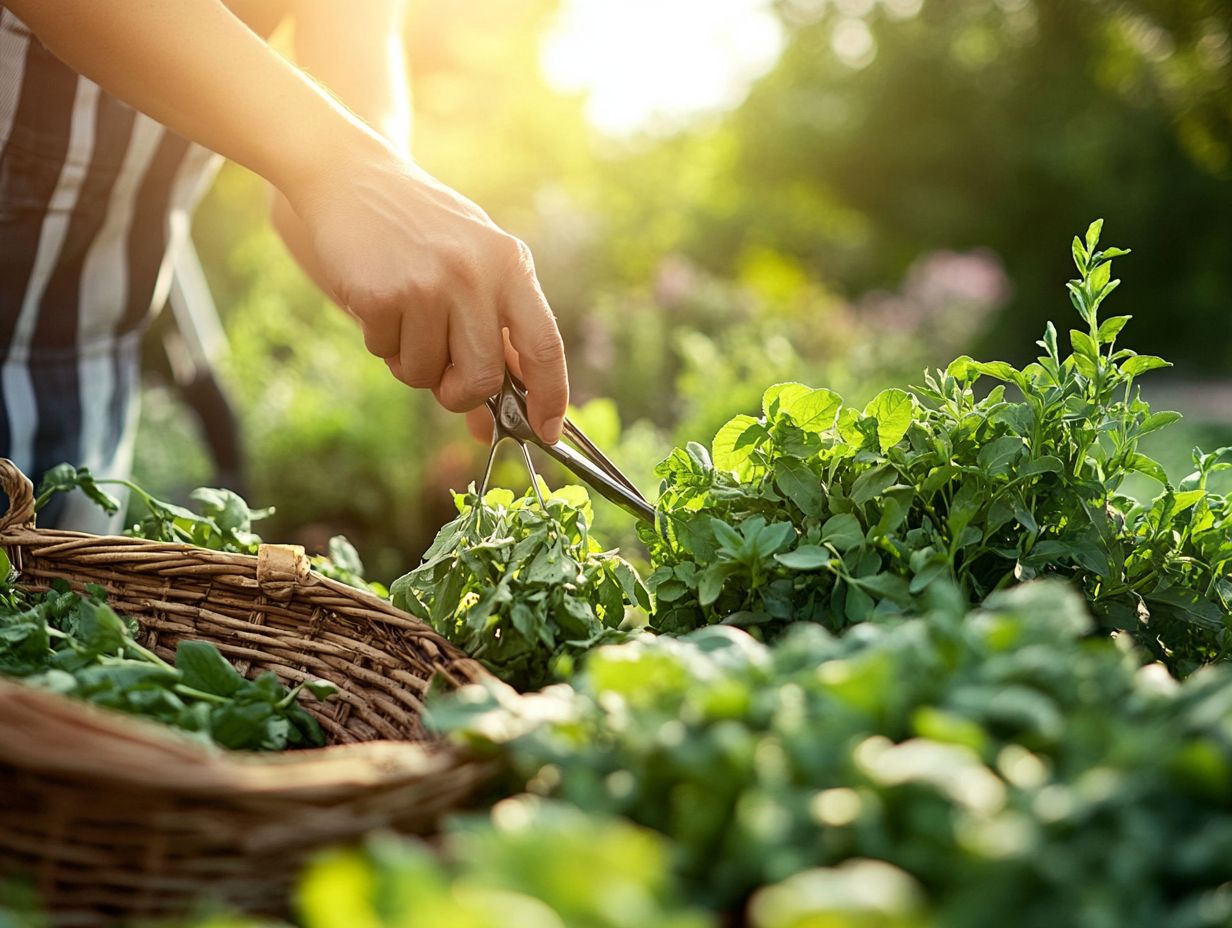
Avoid common mistakes in harvesting and storing herbs to keep their flavors strong!
Many enthusiasts often overlook proper storage techniques, leading to significant damage and a decline in quality. For instance, wrapping fresh herbs in a damp paper towel before placing them in the refrigerator can help maintain moisture and prevent wilting.
Understanding the ideal conditions for herbs, such as humidity and light, can stave off spoilage and even enhance their medicinal properties.
Start your herb garden today and enjoy fresh flavors in your cooking year-round!
Tips for Avoiding Damage to Plants and Loss of Quality
Protecting your plants is essential for their health and culinary potential. Proper handling during harvest is crucial. For example, gently twisting the stems instead of cutting them reduces stress on the plant.
Storing herbs in optimal conditions like a cool, dark place will help prevent wilting and maintain their essential oils. Using airtight containers is also a smart move to preserve flavor intensity and medicinal properties.
Timing your harvest is equally important. Gather herbs in the early morning when moisture levels are at their peak to enhance their potency. It’s vital to understand the specific needs of each herb, including humidity and airflow, which means the movement of air around your herbs is key. High humidity can promote mold growth, so keeping your herbs dry before storage is a wise practice.
Methods like drying, freezing, or infusing in oils can extend their shelf life, ensuring your culinary creations remain vibrant and full of flavor.
By following these actionable strategies, you can guarantee that your herbs stay fresh and retain their full array of benefits.
Using Harvested Herbs
Using harvested herbs opens up a world of delicious and healthy options, inviting you to elevate your dishes and enhance your wellness routine. Picture incorporating vibrant herbs like basil and rosemary into your recipes for an explosion of flavor while also exploring the medicinal side with soothing herbal teas or tinctures crafted from chamomile and feverfew.
Infusing your water with herbs adds a refreshing twist and delivers health benefits, illustrating the remarkable versatility and worth of homegrown herbs.
Culinary and Medicinal Uses
Culinary and medicinal uses of herbs present you with a wealth of benefits, enhancing flavors in your dishes while providing holistic health support.
Take basil, for example. It’s not just a delightful addition to your salads and pasta; it also boasts anti-inflammatory properties. Similarly, chamomile serves as both a calming tea and a digestive aid.
By incorporating these herbs into your everyday recipes, you foster a sustainable lifestyle that promotes wellness, making them essential staples in both your kitchen and medicine cabinet.
Consider the vibrant culinary versatility of rosemary, which elevates roasted meats and vegetables with its aromatic charm while offering a rich antioxidant profile that supports cognitive health. Turmeric shines as well not only does it add a striking hue to your curry dishes, but it also wields powerful anti-inflammatory effects that enhance overall well-being.
By exploring these herbs, you can seamlessly blend flavorful cooking with natural remedies, enriching your dietary practices while nurturing your health. This holistic approach not only supports your personal wellness but also deepens your connection with the culinary arts.
Frequently Asked Questions
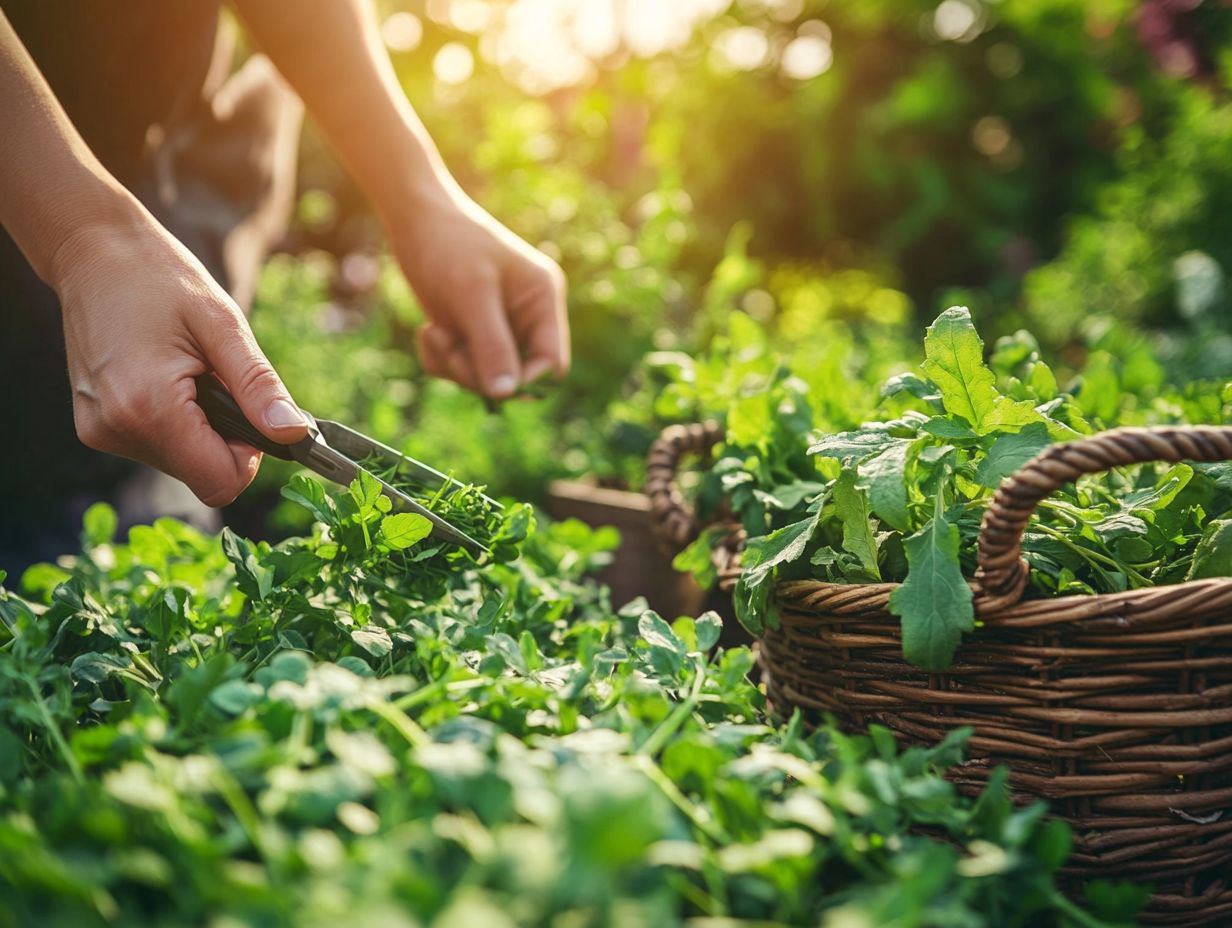
What are the best practices for harvesting herbs?
The best practices for harvesting herbs include choosing the right time of day, using proper tools, and storing the herbs correctly.
When is the best time of day to harvest herbs?
Harvest herbs in the morning after the dew dries but before it gets too hot.
What tools should I use when harvesting herbs?
When harvesting herbs, it is best to use sharp, clean scissors or pruning shears to avoid damaging the plants. Avoid using your hands to pull or twist the herbs as this can also cause damage.
How should I store harvested herbs?
Harvested herbs should be stored in a cool, dry place to maintain their freshness. You can either hang them upside down to dry or place them in a paper bag with air holes.
Can I harvest herbs throughout the growing season?
Yes, you can harvest herbs throughout the growing season, but it is important to only take a small amount from each plant at a time to allow for continuous growth.
Are there any herbs that require special harvesting practices?
Yes, some herbs such as basil and cilantro should be harvested frequently to prevent them from flowering and becoming bitter. Other herbs, like rosemary and thyme, can be harvested less frequently.


